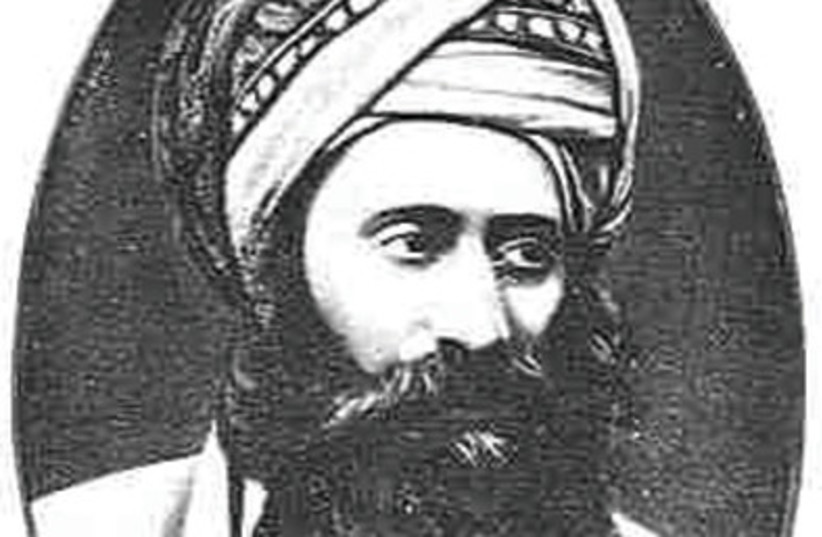Polemic tracts against the Hassidim refer to adherents of the nascent movement as mit’hasdim. The term is based on the Hebrew root “het samech dalet.” This root appears in the Mishna to refer to pious people of old, hassidim, whose conduct went beyond the letter of the law. Thus, for example, the early hassidim would wait an hour before beginning their prayers in order to direct their focus to God (Mishna, Berachot 5:1).
When 18th-century writers railed against emerging trends of piety which they saw as misguided, they could not refer to these whippersnappers by the lofty appellation “hassidim.” So one solution was to use the reflexive voice (hitpa’el), indicating that the upstarts were trying to pass themselves off as pious: mit’hasdim.
IN 1784, the community of Vilna sent a letter to the community of Pinsk recommending that communal leaders remove their rabbi who joined the ranks of the nascent movement. The unnamed rabbi appears to have been the famous Rabbi Levi Yitzhak (1740-1809), who went on to serve in the Berditchev rabbinate.
The Vilna community had heard that the rabbi of Pinsk was supporting those who had “made up practices and customs from their heart, that our holy forebears had not imagined; they are the sect of the suspicious [ha-hashudim – also a play on the word “hassidim”] and those who pretend to be pious [ha-mit’hasdim].”
Twelve years later, in 1796, the community of Vilna dispatched a copy of a letter penned by the leading rabbinic authority of the anti-hassidic faction, Rabbi Eliyahu of Vilna (the Gra, 1720-1797). The letter denied a rumor that the Gra had regretted and retracted his staunch anti-hassidic position. In the prologue to the letter, the community noted that “a number of people from the mit’hasdim spread out in a number of states in Europe to ensnare souls of the children of our people.”
Even early hassidic masters used the term when they wanted to disassociate themselves from inappropriate behavior. In 1778, Rabbi Menahem Mendel of Vitebsk (1730-1788) sent a letter to Vilna. Less than a year beforehand, Rabbi Menahem Mendel had moved to the Land of Israel, together with a cohort of hassidim. The primary goal of the letter was to encourage financial support for the hassidic community in the Holy Land, though the writer also mentioned his attempts to settle the tensions between the warring factions before he left the shores of Europe. In his letter, he acknowledged that young upstarts had presumptuously been mit’hasdim – assumed mantles of piety for themselves.
Thus it was clear to both the hassidim and their opponents, the Mitnaggedim, that using the reflexive “mit’hasdim” was a pejorative term.
BUT NOT everyone understood that the reflexive “mit’hasdim” was a derogatory appellation. The great Baghdadi scholar Rabbi Yosef Hayim (1835-1909) used the term to positively describe those who strive for piety.
For example, in his 1898 Ben Ish Hai, when discussing the laws of respect for parents, Rabbi Yosef Hayim noted that children may not call their parents by name. Writing, however, is not the same as speaking, and it is permitted for a person to sign a letter and add the parents’ names. Notwithstanding – added Rabbi Yosef Hayim – there are mit’hasdim who would write their name and add “son of my master, my father” and then add the parent’s name. Rabbi Yosef Hayim noted that this was not required, but he did not disparage the practice.
Elsewhere in his work, Rabbi Yosef Hayim wrote that washing is forbidden on the Tisha Be’av fast. Even the morning ritual washing of the hands should be minimized to washing until the knuckles rather than the wrist. After discussing other Tisha Be’av laws, Rabbi Yosef Hayim returned to washing and added that there are those who are mit’hasdim and they perform the ritual washing of the hands until the wrist after the fast is over. In this case, Rabbi Yosef Hayim was not only presenting an option for those who strove for pious conduct, but he noted “and thus we are accustomed” – attesting to his own practice. Rabbi Yosef Hayim quickly added “but this is not obligatory according to the letter of the law.”
In his mysteriously pseudonymous work, Torah Lishma, Rabbi Yosef Hayim framed a question that also used the reflexive term. He asked about those who are mit’hasdim and go to a ritual bath after coming in contact with a dead person. After discussing various traditional sources, Rabbi Yosef Hayim concluded that those mit’hasdim “act appropriately and their practice is good.”
That is not to say that everything that mit’hasdim do is worthy. In another Torah Lishma responsum, Rabbi Yosef Hayim asked about mit’hasdim who wanted to read the Aramaic translation of the Torah with the cantillation marks. For Kabbalistic reasons, Rabbi Yosef Hayim rejected this idea: cantillation marks were reserved for the holy books in Hebrew. Translations, even those accepted by tradition, were not to be read with the traditional musical notes. Here the conduct of mit’hasdim – good-intentioned though it may have been – was ill advised.
THE TRUTH is that the Baghdadi use has a biblical antecedent.
The Hebrew root “het samech dalet” is common in the Bible, appearing over 250 times. But only once does the root appear in the reflexive form.
In King David’s song of praise (II Samuel 22), the poet praises God, acknowledging divine salvation and justice: the righteous are rewarded and the wicked are punished. In this context, the reflexive form appears in reference to God: “With the pious one, You show Yourself to be pious [tit’hasad], with a mighty person who is blameless, You show Yourself to be blameless” (ibid., v. 26).
THE TRUTH is that the vicissitudes of the reflexive form “mit’hasdim” go beyond the sources recounted here. Whether or not it is good to be among the mit’hasdim is, therefore, dependent on context.
In the hassidic milieu, we would not want to be branded as mit’hasdim – people who presumptively assume a cloak of piety. Yet a century ago in Baghdad, we would strive to be one of the mit’hasdim, just like the famed Rabbi Yosef Hayim.
The writer is on the faculty of Pardes Institute of Jewish Studies and is a rabbi in Tzur Hadassah.

